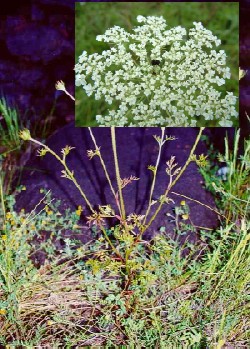

Wild Carrot (Daucus carota)
Folk Names: Bee's Nest, Bee's Nest Plant, Bird's Nest, Bird's Nest Root, Devil's Plague, Elaphoboscum (Greek), Philtron, Queen Anne's Lace, Sisaron (Greek), Staphylinos (Greek)
Description: The carrot is biennial and grows in temperate parts of America. It is closely related to the Parsnip and Skirret. When it grows wild, it has a tough, slender, white, vertical root and a rosette of ferny leaves in the first year. Only cultivated members of this species have the succulent sweet root we have al come to know and love. The ribbed stem is hairy and branched, appearing the following year and reaching up to two to three feet. The leaves of the stem are alternate, bipinnate and cut into many fine divisions and delicate pronged green bracts near the base of the flower. The seven to thirteen, stiff, three-forked bracts appear under the umbel. Lacy white concave umbels of flowers with red-purple dot in the center appear from April to October. The flower heads close up to a cup shape when it goes to seed.
Effects: strong
Planet: Mars, Mercury
Element: fire
Associated Deities:
Traditions:
The red flower in the middle of the flower head is said symbolize a drop of blood from Queen Anne (1665-1714) who pricked her finger making lace.
The name carrot is Celtic and means “red of color.” Daucus comes from the Greek dais, meaning “to burn.”
Magic:
Women are instructed to eat carrot seeds for fertility, especially wild ones. Carrots may also be eaten for lust and to cure impotence.
Some folklore says that eating carrots or their seeds will allow one to see in the dark.
The red flower at the center of the flower head is said to prevent epileptic seizure.
Known Combinations:
none noted
Medical Indications: (Caution: Do not mistake with poisonous hemlocks which does not have a hairy stem.) Parts Used: root, seed
Carrot is an anthelmintic, carminative, diuretic, and stimulant. The leaf or root tea is used for kidney disease, stones, and bladder problems. Carrot shavings in a little lemon juice may be used in astringent masks for oily skin. Carrot soup is easily digestible for those with stomach or intestinal problems and is an excellent convalescent food for diarrhea. It prevents putrification in the intestines and gastrointestinal catarrh. The juice is also useful for treating acidity and heartburn. In addition, the essential oil of the seed is effective against roundworm. Eating two to three seeds a day for several days would be just as effective as the oil. An infusion or decoction of seeds is used for flatulence, and to promote menstruation. A poultice of the root or the leaves with honey are soothing for skin ulcers and running sores.
Nutrition:
The root is tough and woody but in a first year plant, it is still edible and may be harvested in the fall to early spring. Cook it in vegetable stews. Personally, I prefer carrots raw and crunchy.
Sugar syrup may be made from carrot juice, and the roots can be dried and powdered to make flour for bread. Carrots also contain more than enough pectin to make them suitable for jams and jellies.
In Germany, finely chopped carrots have been roasted and used as a coffee substitute. In France, England, and Germany, the root has been used to make alcohol. What is left from this brewing may be fed to the pigs.
Mercantile Uses:
Wild carrot is used in livestock feed.
The flowers and stalks may be combined with alum for a yellow dye.